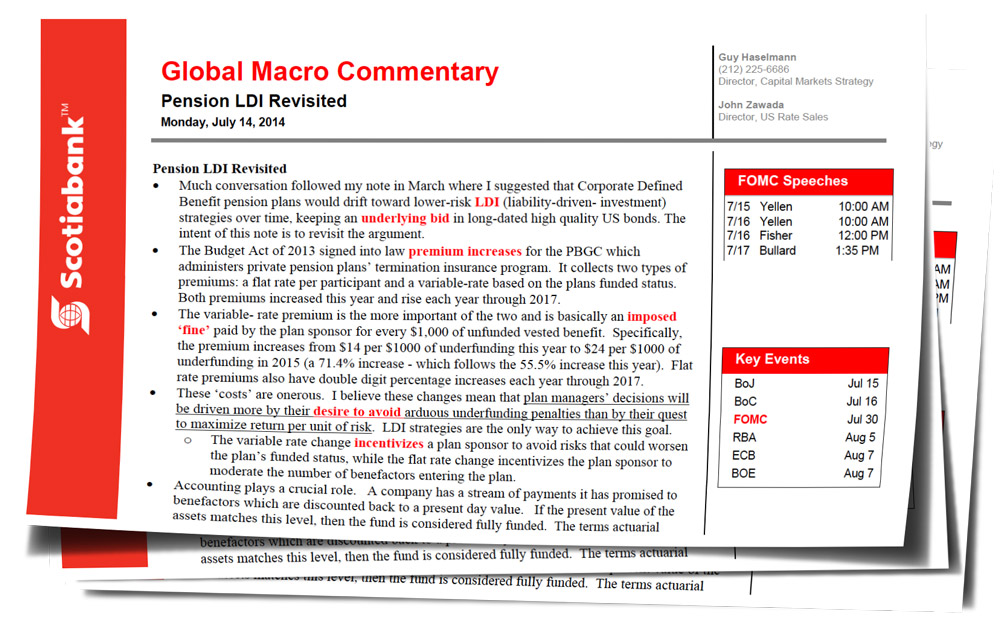by Guy Haselmann, Director, Capital Markets Strategy, Scotiabank GBM
Pension LDI Revisited
· Much conversation followed my note in March where I suggested that Corporate Defined Benefit pension plans would drift toward lower-risk LDI (liability-driven- investment) strategies over time, keeping an underlying bid in long-dated high quality US bonds. The intent of this note is to revisit the argument.
· The Budget Act of 2013 signed into law premium increases for the PBGC which administers private pension plans’ termination insurance program. It collects two types of premiums: a flat rate per participant and a variable-rate based on the plans funded status. Both premiums increased this year and rise each year through 2017.
· The variable- rate premium is the more important of the two and is basically an imposed ‘fine’ paid by the plan sponsor for every $1,000 of unfunded vested benefit. Specifically, the premium increases from $14 per $1000 of underfunding this year to $24 per $1000 of underfunding in 2015 (a 71.4% increase - which follows the 55.5% increase this year). Flat rate premiums also have double digit percentage increases each year through 2017.
· These ‘costs’ are onerous. I believe these changes mean that plan managers’ decisions will be driven more by their desire to avoid arduous underfunding penalties than by their quest to maximize return per unit of risk. LDI strategies are the only way to achieve this goal.
o The variable rate change incentivizes a plan sponsor to avoid risks that could worsen the plan’s funded status, while the flat rate change incentivizes the plan sponsor to moderate the number of benefactors entering the plan.
· Accounting plays a crucial role. A company has a stream of payments it has promised to benefactors which are discounted back to a present day value. If the present value of the assets matches this level, then the fund is considered fully funded. The terms actuarial assumption, assumed rate of return, and discount rate are therefore interchangeable. Pension liabilities have bond-like features such as an inverse relationship to interest rate movements; in such, aligning the duration of assets with the duration of liabilities simultaneously aligns market risk with the accounting risk of the plan.
· There will be funding level volatility any time the asset allocation differs from the way in which the liabilities are evaluated. The only way to avoid this is to reduce the liability or the asset / liability mismatch. Since funding status shows up directly on a corporate balance sheet, funding status volatility also means unwelcomed balance sheet volatility.
· The enormous asset / liability mismatch of SIV’s during the 2008 crisis was a factor that seized interbank lending and worsened the crisis. These new PGBC rules were likely based on the desire to avoid a similar situation. Going forward, rules could be changed again to reduce risks further. Moreover, since the government is incentivized to ensure that there are enough adequate buyers of its (Treasury) debt, it is not farfetched to believe that future rules could require closer match of pension liability cash flows to assets.
· It is only prudent for pension sponsors to align assets more closely with liabilities; especially since, funding levels have risen substantially in recent years to more healthy levels, and the penalties for returning to deep underfunded status get more punitive over time. When the UK mandated matching in the 1990’s, first movers had an enormous advantage.
· Towers Watson, Millman, and the Fed have all published material on private pensions. For consistency’s sake, and to minimize argument, I will use Fed data which is updated through Q1 2014. These numbers can vary significantly depending on the source. There are $3.082T in private DB pension plans in the US which are 93% funded on average. (Others have almost $4T in assets 85% funding). All else being equal, the Fed data means that the 2015 variable rate premium (i.e., penalty) paid will be $3.02B in 2014 and $5.17B in 2015 (vs. $1.94 billion in 2013). A direct hit to a firm’s bottom line.
· Of the $3.08 trillion of assets, 24% is currently invested in fixed income. If the rule changes cause a doubling of the fixed income allocation to 55% (for fun, let’s assume only Treasuries), then this would equate to 100% of the entire secondary market float of long- dated Treasury securities (10 years and longer). I maintain that long Treasuries have commodity (shortage) characteristics and should be bought. For the reasons outlined herein, as well as the numerous outlined in earlier notes, my forecasts for the 30 year Treasury bond remains for a 2014 new yield low by the end of the summer, and for a sub- 3% yield by the end of the year.
“How many times can a man turn his head and pretend that he just doesn’t see” –Bob Dylan
Read/Download full commentary below:















